|
The United States Naval Hospital
99 Bluff, Yokohama, Japan
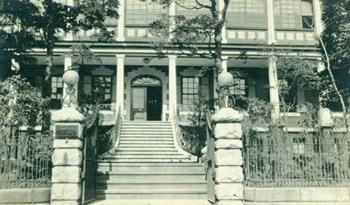
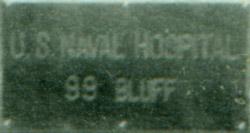
Before and After the
Great Kanto Earthquake
of September 1, 1923
The photographs below are of the US Naval Hospital (USNH) in Yokohama located at 99 Bluff. The photographs show the hospital before the Great Kanto Earthquake of 1923 and one shows the spot where the hospital stood immediately after the earthquake and resulting fire-storm that obliterated the structures on the Bluff and in the foreign settlement area below as well as the entire City of Yokohama. It appears that the destruction was so great that not one pre-1923 earthquake building on the Bluff remained a viable structure.
The USNH opened in the Bluff area of Yokohama in 1872. The month of May is generally cited but that is uncertain. It appears that it was located on the lot know as 99 Bluff as early as 1880 and probably since it was opened in 1872. While it clear that a US Naval Hospital occupied 99 Bluff for many years, it has been established that a new hospital was built there in 1909. This is the facility that was destroyed by the Great Kanto Earthquake of 1923. The Los Angeles Herald reported the completion of the "new" US Naval Hospital in the February 9, 1909 edition of the paper. The article reads:
U. S. NAVAL HOSPITAL AT YOKOHAMA COMPLETED
Peculiar Custom of the Japanese Carpenters Is Cause of Delay in Building.
WASHINGTON, Feb. 8. After some delay in the construction, the new United States naval hospital at Yokohama, Japan, is about ready for occupancy. The building is a frame one of Japanese architecture and cost $25,000. It was constructed by Japanese builders and the delay was caused by the custom of the Japanese in first erecting the building complete on a temporary site by way of demonstration. This is done for the purpose of inspection, and if the building is accepted it is then to be taken down and erected on the permanent site. The hospital will be in charge of Medical Inspector W. R. Dubose. (Los Angeles Herald, Volume 36, Number 131, February 9, 1909 at page 2 - found here).
I believe that the photographs below show the hospital that was completed in 1909.
The English Hospital was adjacent to the USNH. It was on the side of a hill that ran down the Bluff to the waterfront. A stereoview from ca 1877 showing the British hospital is here. The stereoview captioned as the English Hospital shows a building on the bay (17 Bluff) across the canal from the Grand Hotel. As established by the map below, by ca 1898 the British hospital was up the bluff at 115 Bluff. The area identified in the stereoview as the English Hospital is noted on that map as the "British Naval Depot." It is possible that the early stereoview mis-identified the British Naval Depot as the English Hospital. A German hospital was located at 41 and 42 Bluff next to the "Bluff Gardens." It was opened in 1878.
The photograph of the back of the USNH (below) shows a cemetery in the foreground. The Yokohama Foreign General Cemetery was located on Bluff lots adjacent to 99 Bluff which was to the east. If this is that cemetery, that would mean that the hospital was aligned with the front facing the Bay and the back to the Foreign Cemetery and Camp Road being to the front and the primary route of access.
An excellent book regarding the Great Earthquake of 1923 was written by Otis Manchester Pool. The book is titled The Death of Old Yokohama in the Great Earthquake of 1923 (1). Mr. Poole had been a resident of the Bluff (No. 68 Bluff) since 1888 and the book is based upon his first hand record of the earthquake which he made a few weeks following the disaster. He described the location of the various foreign hospitals and activities on the Bluff this way:
The French Camp occupied the foot of the first gully running from the Settlement up the adjoining headland, while the larger British force camped just over the crest. Thus the road running up the gully acquired the name of 'Yato-Zaka' or Camp Hill. At the top of this hill, on the left, the British established a Naval Hospital, with terraced lawns running down to the edge of cliffs overlooking the Bay.
Similarly the United States established its Naval Hospital on the right-hand crest of Camp Hill opposite the British Camp; but beyond the medical staff no more than a small marine guard was quartered there.... (page 22).
There is a sketch map of the Yokohama "Foreign Settlement and Middle Bluff" area in the book. Based upon the sketch map, it appears the US property covered Buff numbers 97, 98 and 99. Camp Hill road, running up the hill between the USNH (on the right going up the hill) on one side and the French and British bases on the other, appears to be the primary means of entry and exit for all these activities. In a sketch map (shown below) published c1898, it does not appear that the USNH property extended as far down the hill as 97 Bluff. In addition, the earlier sketch map does not show the French camp. The French activity was occupied by French Marines from 1863 to 1875. It is unclear what the disposition of that property was after 1875. I have seen accounts that state the French Consulate was placed on that site ca 1894. The map below (c1898), however, shows the French Consulate at No. 84 in the Settlement. Regardless of the exact locations, by September 2, 1923, all these buildings were reduced to piles of charred rubble.
An informative article on the hospital can be found in The Grog (2) for the Spring of 2011. The article is titled "The Day the Naval Hospital Fell: Navy Hospital Yokohama and the Great Kanto Earthquake of 1923," and it can be found at pages 4-8. This article provides a historical perspective on the hospital but the focus in on the fateful day of September 1, 1923 when the Great Kanto Earthquake destroyed it and most of the city of Yokohama.
The destruction of the USNH added a sad but interesting footnote to US Marine Corps history and lore. The article in The Grog contains references to Pharmacist (US Navy) Lawrence Zembsch who had returned from a mission to retrieve the body of a Marine officer who had died on Palau (Caroline Islands). He returned from the assignment with the cremated remains and he was hospitalized for "nervous exhaustion." Both Zembsch and his wife were killed at the USNH in the earthquake. The Marine Corps Gazette, published an article titled "The Unsolved Mystery of Pete Ellis." Pete Ellis was the officer in question and a LtCol in the US Marine Corps. This article can be found here.
In Yokohama Burning (3), Joshua Hammer provides a riveting account of the Great Kanto Earthquake and the impact on Yokohama and Tokyo. Hammer discusses the marine officer, Pete Ellis, and the mission by Pharmacist Zembsch to recover his remains (see pages 23-24 - the "Ellis Affair"). Several discussions in the book relate specifically to the situation at the US Naval Hospital before and after the earthquake (see pages 60, 104 & 204). Additionally, there are two photographs of the rubble of the hospital (see pages 207 & 218).
I believe that the old Bluff addresses are now designated as "xxx Yamate-cho, Naka-ku, Yokohama-shi, Kanagawa-ken, 231-0846 or 0862, Japan." Thus, the current address for 99 Bluff would be "99 Yamate-cho, Naka-ku, Yokohama-shi...." It appears that the old lot numbers remain and when they are subdivided that is indicated by a dash and number (i.e. "115-3"). To see maps of this location (Naka Ward, Yokohama City) click here and here.
The address for the Yokohama Foreign General Cemetery is now 96 Yamate-cho, Naka-ku. You can see a Google Map view of that address here (zoom in on the "A"). Once your are on that Google map page enter "Yamatecho, 99, Yokohama, Kanagawa Prefecture, Japan" in the search block. That will show you the parking lot of a 4 story apartment building to the right of the cemetery. This link will take you directly to 99 Bluff on Google map. I believe this is the general location where the US Naval Hospital once stood. The area where the British hospital was located is shown on the map further to the right as the "British House" at 115-3 Yamate-cho, Naka-ku.
The Grand Hotel was in the foreign settlement area below the Bluff. The Great Kanto Earthquake of 1923 destroyed almost all of the structures on the Bluff and in the foreign settlement where the Grand Hotel was located. For information on the Grand Hotel, click here.
1. Poole, Otis Manchester, The Death of Old Yokohama in the Great Japanese Earthquake of September 1, 1923, London, George Allen and Unwin, Ltd, 1968, large 12mo, red cloth with gilt lettering on the spine, dust jacket, frontispiece photograph of the author, 14 black and white halftone plates each reproducing 2-3 photographs, 2 maps/plans (Yokohama, 1923 & The Japanese Earthquake of 1923), 135 pp. More information on this book is here.
2. The Grog, A Journal of Navy Medical History and Culture, Spring 2011, Volume VI, Issue II, Bureau of Medicine and Surgery, Office of Medical History, Falls Church VA. The Spring 2011 edition is posted in PDF format here.
3. Joshua Hammer,Yokohama Burning, The Deadly 1923 Earthquake and Fire that Helped Forge the Path to World War II, New York, NY, Free Press, 2006, 8vo, hard cover with dust jacket, 314 pp.
US Naval Hospital, 99 Bluff, Yokohama, before the September 1, 1923 Earthquake.
Front Entrance to the US Naval Hospital, Yokohama.
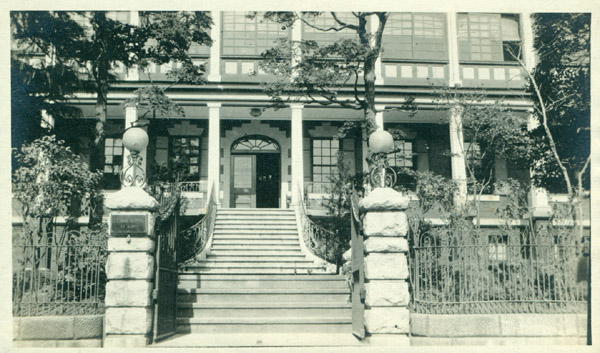 Back View of the US Naval Hospital, Yokohama.
Back View of the US Naval Hospital, Yokohama.
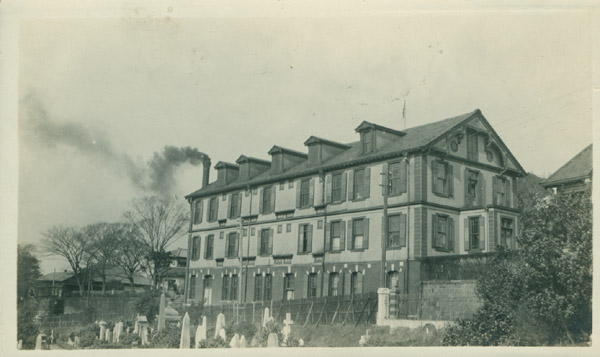 Side View of the US Naval Hospital, Yokohama
Side View of the US Naval Hospital, Yokohama
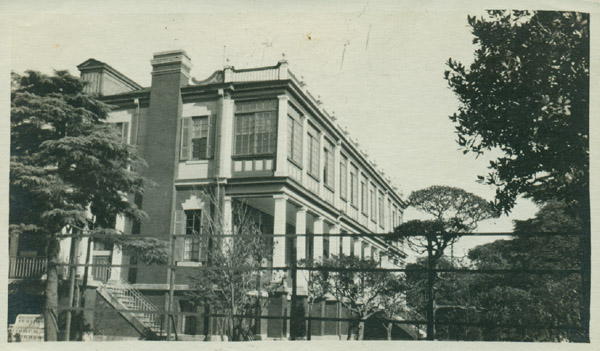
What Remained of the US Naval Hospital, Yokohama after the Earthquake - as viewed from the back..
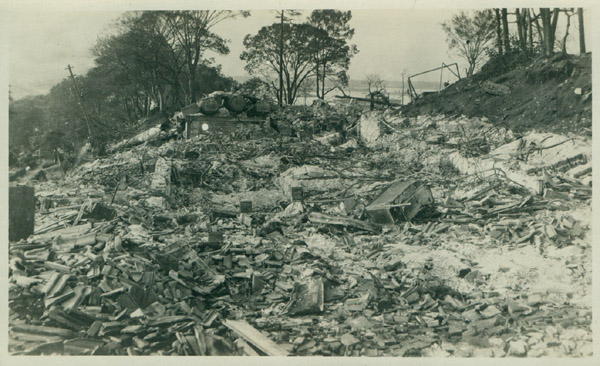 The debris of the hospital as viewed from the front can be seen here.
The debris of the hospital as viewed from the front can be seen here.
Sketch Map of Yokohama and the Bluff Area (ca 1898) with "Bluff 99" Marked.
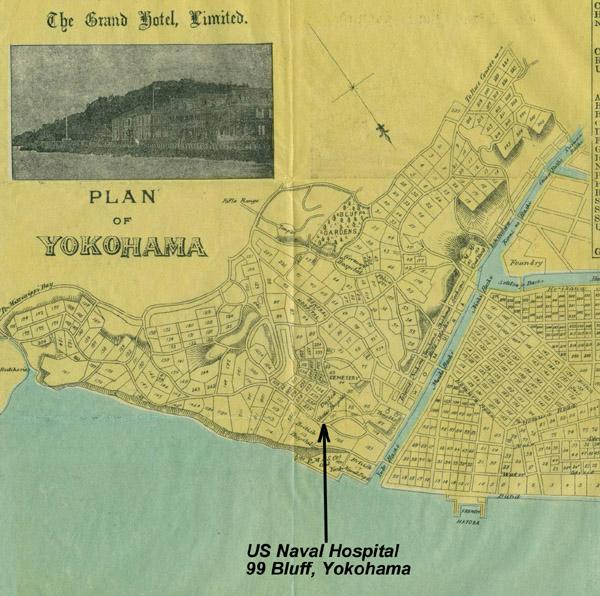
This map (plan) is from a Guide Book published by the Grand Hotel ca 1898. For information on that book, click here.
More Photographs of the Earthquake Devastation along the Yokohama Bund, below the Bluff Area.
Ruins of the Grand Hotel.
 Ruins of the Customs House and Pier.
Ruins of the Customs House and Pier.

General information and images of the devastation caused by the earthquake of September 1, 1923 can be found here.
|








